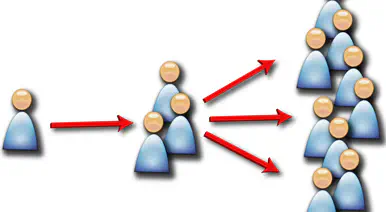The Value of Longitudinal Survey Research
Decision makers in organizations often use questionnaires, interviews, or focus groups to gather information at one point in time. Opinions and feedback from various stakeholders are gathered, sorted and analyzed before decisions about products or services are made and implemented.
This ‘point in time’ data collection is informative and cost efficient. However, this data is often collected from relatively small numbers of individuals with little attention to controlling for differences in cultural or environmental factors between individuals, to name but two potential issues. Further, there is often no follow up to identify changes in thinking or operations; there is no comparison of behaviors, attitudes, or perceptions from one point in the continuum to another.
At the Maastricht School of Management in The Netherlands, De Waal and Frijns were interested in researching factors that caused or contributed to sustainable high performance in organizations in Asia. When considering research methods, they could have constructed interview questions and/or questionnaires to gather information from organizations in Asia about ways in which high performing individuals, departments, divisions, organizations and alliances were identified.
This ‘point in time’ information would certainly have provided a snapshot of current thinking about high performance individuals and organizations. However, given the ever changing global economy and politics, this information would soon be outdated.
How interesting, and how meaningful, would it be to structure the gathering of information over time to discover how individual attitudes and behaviors change as influenced by changes in the politics and local and/or global economy? This is, in fact, what De Waal and Frijns did – a longitudinal study to look at needs and change over time.
Since the behavior of each individual impacts the behavior of the organization, how do those individual changes impact organizational structure, operations, and the design, development, delivery and distribution of services and products?
Gathering information over time, months and years, is a meaningful way to track individual changes as well as subsequent organizational changes. In longitudinal studies, the same individuals are tracked over time to gather quantitative data, qualitative data, or both.
This is especially useful when gathering information on knowledge, skills, attitudes, opinions, and behaviors of individuals that develop across the lifespan or change due to environmental factors in an organization. Psychologists and social scientists study trends across generations. Market researchers identify changes in their target audience that come about due to advertising.
What is significant about longitudinal research is that data is gathered from the same individuals at a minimum of two points in time. First, data is collected from individuals to establish baseline information. Then, data is gathered from those same individuals at least one more time so that some type of comparison can be made.
Most information collected over time involves data collection points over months, years, and/or decades; it is important that data analysis involve comparison of data between or among data collection points or periods to most accurately gauge change over time as well as the effectiveness of an intervention or strategy.
Retrospective studies, a type of longitudinal research, involve a look into the past using historical documents, including medical records, employment records, or documentation chronicling a continuous initiative.
As powerful as information collected in this way can be, it is resource intensive, taking both time and money. It can be challenging to track the same individuals for months and years, since individuals may die or leave an organization, rendering them unavailable to contribute to continued data collection. Thus, the sample size decreases.
Yet, most experts feel that the advantages of collecting information over time tend to outweigh any disadvantages. In Volume One of the Encyclopedia of Survey Research Methods edited by Paul J. Lavrakas, Kalaian and Kasim note that longitudinal research has significant advantages in highlighting change and growth in attitude, perception, behavior, employment, mobility, and retention. In addition, looking at information over time helps predict the long-term effects of that growth and/or change. And, such information is far easier to gather now than ever before given the explosion of technology and social media.
A quick online search reveals that longitudinal studies are conducted in many industries. Everydayhealth.com highlights Kids’ IQ Takes a Hit with Bad Diet and Meth Users Much More Likely to Attempt Suicide. An article in the Annals of Family Medicine reviews examples of and experience with longitudinal research in family medicine to form recommendations for implementing longitudinal research in family practice settings.
From the University of Bristol, Dr. Kate Northstone and colleagues reviewed data on 3,966 children from the Avon Longitudinal Study of Parents and Children. Parents in the study reported the eating habits of their child at age 3, 4, 6 and 8.5 years using a food frequency questionnaire. Several adjustments were made during analysis to account for gender, age at testing, test administrator, and other life events. Results reported online in the Journal of Epidemiology and Community Health indicated that children who eat a diet high in fat, sugar, and processed foods at age 3 appear to have slight deceases in IQ later in childhood.
A Journal of Marketing Research examines the merits of cross sectional vs. longitudinal data collection to understand, explain, and predict marketplace behaviors. Bis.gov.uk showcases longitudinal research on new firms and their growth. A search of research methods reveals that longitudinal studies are often used in studying the process of organizational change.
“The use of longitudinal field research methods is fundamental to understand the dynamics of organizational life and to developing and testing theories of organizational adaptation, change, innovation, and redesign,” note George Huber and Andrew van de Ven, authors of Longitudinal Field Research Methods.
The Reykjavik University Centre for Research on Innovation and Entrepreneurship has conducted research on service innovation, experience-based innovation, and the founding and growth of new ventures. The Centre has followed about 200 new Icelandic ventures from the time of start-up with annual questionnaires.
The School of Business at Reykjavik University in Iceland has undertaken a longitudinal study called the Black Box. They anticipate the project will result in recommendations to manufacturers and managers about how to use aesthetic design to differentiate their products from others; how aesthetic design contributes to competitive advantage is also under study. As a result, researchers expect to gain an increased understanding of the relationship between the aesthetic design of a product and its performance.
Another application of longitudinal research in the business sector is that conducted by Allinson, Braidford, Houston, Robinson, and Stone, a Policy Research Group at the University of Durham. They conducted a quantitative survey of 500 Social Enterprises across the United Kingdom to identify many factors including size, growth rate, mission, and legal structure of each Social Enterprise.
A follow up study took a more qualitative approach to seek understanding of the opportunities and challenges faced by Social Enterprises. The availability and quality of support by businesses to overcome challenges were identified as items that should be differentiated and segmented. Should support be segmented to accommodate different business features such as age of business, size, use of volunteers, training and professional development, legal structure, social purpose, or source of income? And, how should that support change over time as the business matures? Such questions continue to be explored.
de Beer, Greet, and Morris wrote a paper that described business participation in different types of government assistance programs. The report detailed statistics about the organization size, industry, and other characteristics. All data presented in the paper was taken from the Longitudinal Business Database that includes all economically significant businesses in New Zealand. This database, which reflects data gathered over decades, allows businesses receiving government assistance to be compared with the general business population at large on an ongoing basis.
Longitudinal research is also prevalent in the medical field. In the Annals of Family Medicine, Chris Van Weel, M.D., Ph.D., reported on three longitudinal studies to identify factors to support other clinicians in longitudinal research. The ultimate goal of the research was to optimize patient care in the family medicine setting.
The study involved primary care practice-based research networks, where 12,000 people were tracked over 30 years. Results from this comprehensive research included recommendations for developing protocol to conduct longitudinal research in family practice settings, how to standardize data collection and train family physicians and staff in data collection, characteristics of facilities appropriate for ongoing measurement of patient health status or chart review, and how to track patients who leave the practice area — the latter, an attempt to address one of the greatest challenges of longitudinal research.
Universities often have centers related to longitudinal research. One such example is the University of Auckland’s Centre for Longitudinal Research. One of the exciting aspects of longitudinal research is the opportunity for collaboration between professionals in multiple disciplines. At the Centre, such disciplines include medicine, health sciences, science, business, and education.
All disciplines have been involved in the Growing Up in New Zealand study, which involves about 7,000 children and their families; the study focus is to discover what it is like to be a child growing up in New Zealand in the 21st century and to draw pathways that lead to successful child development. The first phase gathered snapshots of family life over a year.
The information in the second phase of the study is being collected using face-to-face interviews and telephone interviews with mothers and/or caregivers of children over a second 12 month period. It correlates information gathered during the interviews with information from birth records, postnatal records, and other data sources from year one.
The first report stressed the importance of the first 1000 days of life (i.e., from the onset of pregnancy to two years of age) in ensuring that children have the start they need in life to progress to a healthy future. This information will feed directly into public health policy decisions.
Results from a longitudinal study done at the Harbin Institute of Technology Shenzhen Graduate School addressed trust, satisfaction, and loyalty in customers to electronic businesses. Results showed that the trust online consumers demonstrated at the pre-purchase stage had a significant positive impact on their satisfaction post-purchase. In turn, this trusting relationship had a positive impact on customer loyalty to the vendor.
Results from a longitudinal research study at Trinity College in Dublin reveals individual and collective experiences of women business enterprises. Women business owners were interviewed in three phases between. During the first interview, information was gathered on what motivated the women to start their business, their previous work experience, domestic responsibilities, business financing, business problems, and employment policies.
The second and third interviews focused on changes in any number of areas and the reasons for those changes. Resulting information provided insight into factors that led to business survival and long term success; the interviews also captured the increased depth each woman had of her own situation over the data collection period.
The richness of data gathered over months and years cannot be underestimated; the breadth and depth of information resulting from longitudinal research is unprecedented. It can be expensive, but those costs can be contained with careful attention to the design process. But, there is no better way to document change in attitudes, behavior, perception, employment, mobility, and retention. In most cases, it is the only way.
If you would like to learn more about how NBRI can work with you to document change in your company, customer base, effects of marketing strategies, and many other areas, contact us at 800-756-6168.
Terrie Nolinske, Ph.D.
Research Associate
National Business Research Institute




























 By submitting this form you agree to our
By submitting this form you agree to our